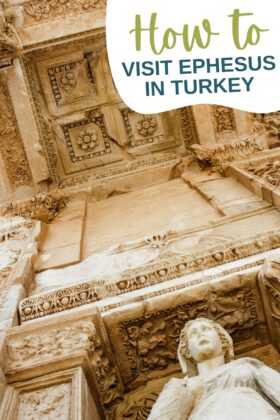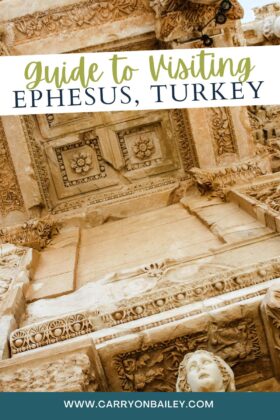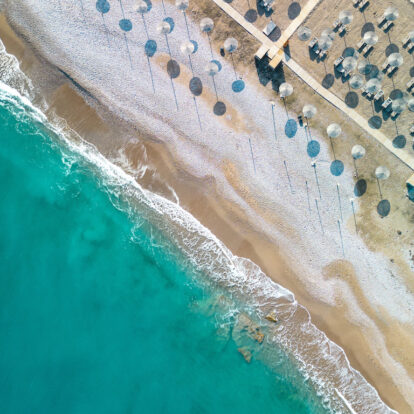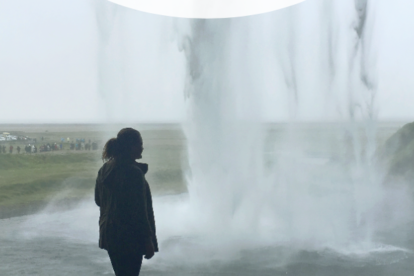Ephesus is an absolute must see if you’re anywhere near the area when visiting Turkey. Steeped in history, it is one of the best preserved and cared for ruins of an ancient city you could find. Explore the amphitheater where Paul spoke to the Ephesians. Tour the terrace houses packed with mosaic art from hundreds of years ago. Visit the House of the Virgin Mary. Whether you’re in it for history or religion, Ephesus is an inexpensive and educational wonder that you will not regret visiting!

Other Turkey Posts You’ll Love:
- 3 Day Fethiye Itinerary
- 5 Best Day Trips From Fethiye
- 3 Day Guide to Cappadocia
Getting to Ephesus
Ephesus is about three miles west of Selçuk. If you have a vehicle at your disposal it’s about a fifteen minute drive from the town. Head out of town on D515 and hang a left on Efes Yolu. The signs will guide you and they’re set up in an easy to follow visible manner. Before you even think about needing to stop for a bathroom break, you’ve arrived!
Driving
The parking lot at the north end is the bottom of the hill. This is the one you should park in if you want to optimize your Ephesus experience. There are abundant taxis who are there to drive you to the top of the hill (the southern end) so you can make one trip down the hill through Ephesus and not have to backtrack to your car.
Depending on the time of year and time of day you visit it will save both time and energy. It’s an inexpensive ride and the driver will offer to take you to the House of Mary and wait for you at the car and take you back down to Ephesus. Both the drive and the House of Mary don’t take too long so it’s a nice addition to your Ephesus day!

By Bus or Tour Group
There are tours that will take you to Ephesus from Selçuk, Bodrum, Kusadasi, Izmir, and even Istanbul (though that one is a little more time consuming). These will get you to Ephesus, in, out, and back to your home base easily. Most of them will even pick you up from your hotel, or a central meeting point close by.
If you’re visiting on your own and don’t have a rental car there are ample busses available to get you to Ephesus. About every 20 minutes during the warmer months from Izmir and Kusadasi to Selçuk. From Selçuk you could even walk from the city center in about 30 mins! Kusadasi to Ephesus is about a half hour bus or taxi ride and will cost you $5 USD give or take. To get there from Izmir the ride is around an hour and a half and will run you about $6 USD. Double that for taxi but it will be a faster ride.
Recommended Tour Group Options:
Admission
An admission ticket to Ephesus will run you 100 Turkish Lira (11 Euro). The Terrace Houses (HIGHLY recommended) is an additional 45 Turkish Lira (5 Euro). To enter the House of Mary costs 60 Turkish Lira (6.5 Euro). The Ephesus museum is 25 Turkish Lira (3 Euro). These are the a la carte prices and there are discounted ticket bundles available if you want it all in one.
House of Mary
The House of Virgin Mary is a beautiful spot about three miles from Ephesus. Situated high up on Bülbül mountain, it is the place that Mary and St. John spent their final days after fleeing Jerusalem. This is also where St. John wrote his bible.
Fading from memory around the end of the 18th century, the house was rediscovered when Catherine Emmerich (a German nun) described the area in detail from a dream having never been there. After extensive studies it’s been declared one of the most sacred places on earth by the Vatican and is a destination for pilgrimage.
As it is a sacred site you do want to attempt to dress appropriately for the visit and preserving the overall peacefulness of the location is emphasized. This being said it’s not as strict or enforced as heavily as, say, the mosques in Istanbul or the like.
It is a gorgeous walk through the grounds and does have accessibility ramps and restrooms located close by. One of those places where you can feel the history and significance in the air regardless of your religion or beliefs.
Walk the grounds and admire the tranquility of the place where Mary spent the last parts of her life. Pass through the small church like house and see all the prayers to Mary stashed in the walls outside. It’s a fairly short stop but well worth it whether you stop for the scenery, the peacefulness, or the history.
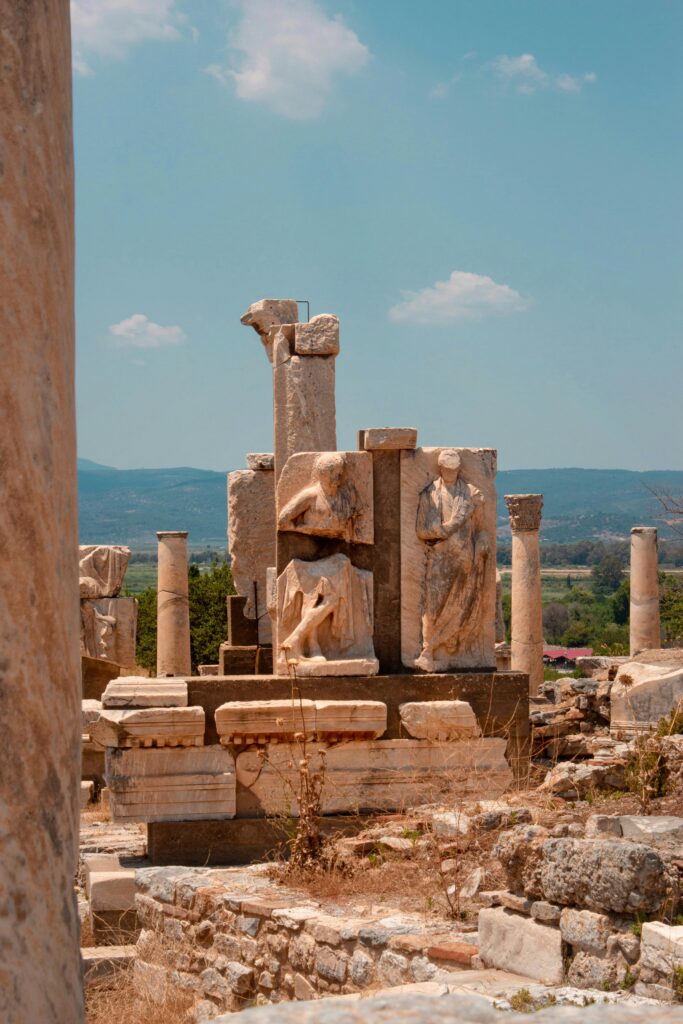
Ephesus (From the top)
Situated outside the gates to Ephesus are a few souvenir shops and vendors. They will likely offer you a guide book in your preferred language and ask if you have water. There is no water for sale within Ephesus so if you haven’t brought water with you it is 100% a good idea to acquire some as it is a sunny warm area and you will be wanting it. The guide book is inexpensive and a good idea if you’re not planning on doing the guided tour. There’s a deluxe version and a cheaper version. Either would do you well to give some extra context to what you’re seeing.
Buying your tickets into the city you can get the ticket just for the city, or for a small amount more get the ticket that allows you to enter the Terrace Houses. Get the tickets with the houses included. It’s not too much extra and the houses are located about halfway down the hill. They are covered to protect them and the shade is incredibly welcome if you’re visiting on a sunny day. Plus they’re packed with information and an impressive sight. More on that later!
Varius Bath
On your right as you enter the ruins of Ephesus is the baths of Varius. The south side of the baths make up the latrines. If you look close enough you can make out the frigidarium or the cold room and the calderium or the hot room.
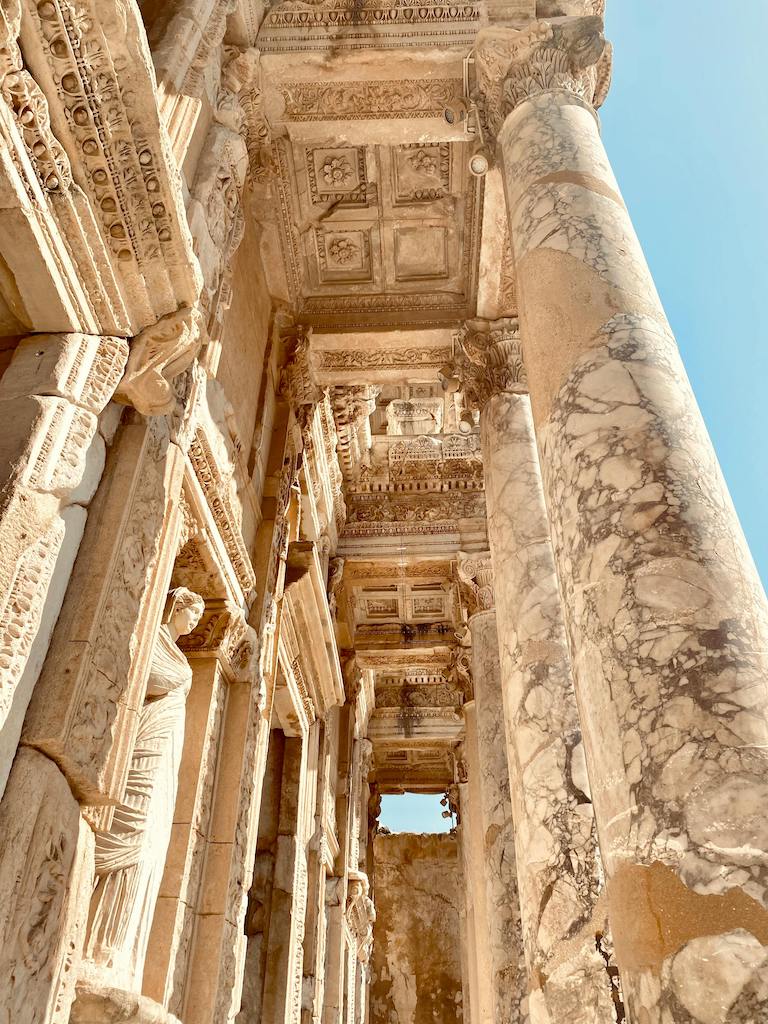
State Agora
Directly across from the baths is the courtyard known at the State Agora. On the north side of the courtyard lies the Odeon. Built in the shape of a theatre, this was where the Senate had its meetings and concerts were held. It’s the smaller of the “theatre” structures in Ephesus and is impressive in its own right.
The south side of the Agora boasts the Prytaneion. Servants called the Prytanes were chosen from noble families kept an eternal flame alight and had control over ceremonies and offerings. You can still see the hearth. Near this hearth was where the statues of Artemis that are on display in the Ephesus Museum were buried.
Domitian Square
Just past the Odeon (the “little theatre”) lies the Domitian Square and the Domitian Temple which gave the square it’s name. A large marble altar sits just behind where a seven meter statue of Emperor Domitian had stood. The statue was visible from all around the city. Domitian’s head and left arm were found during excavation and are on display at the Ephesus Museum.
In the corner of the Domitian square sits the Memnius Monument. Situated on a four step podium, the partially restored monument is decorated with stele reliefs of Memnius, his father Caius, and his grandfather, Sylla. The sides were originally linked together by arches which created the niches for the reliefs. Impressive in it’s current form it’s inspiring to think of what it was back in it’s glory days.
Curettes Road
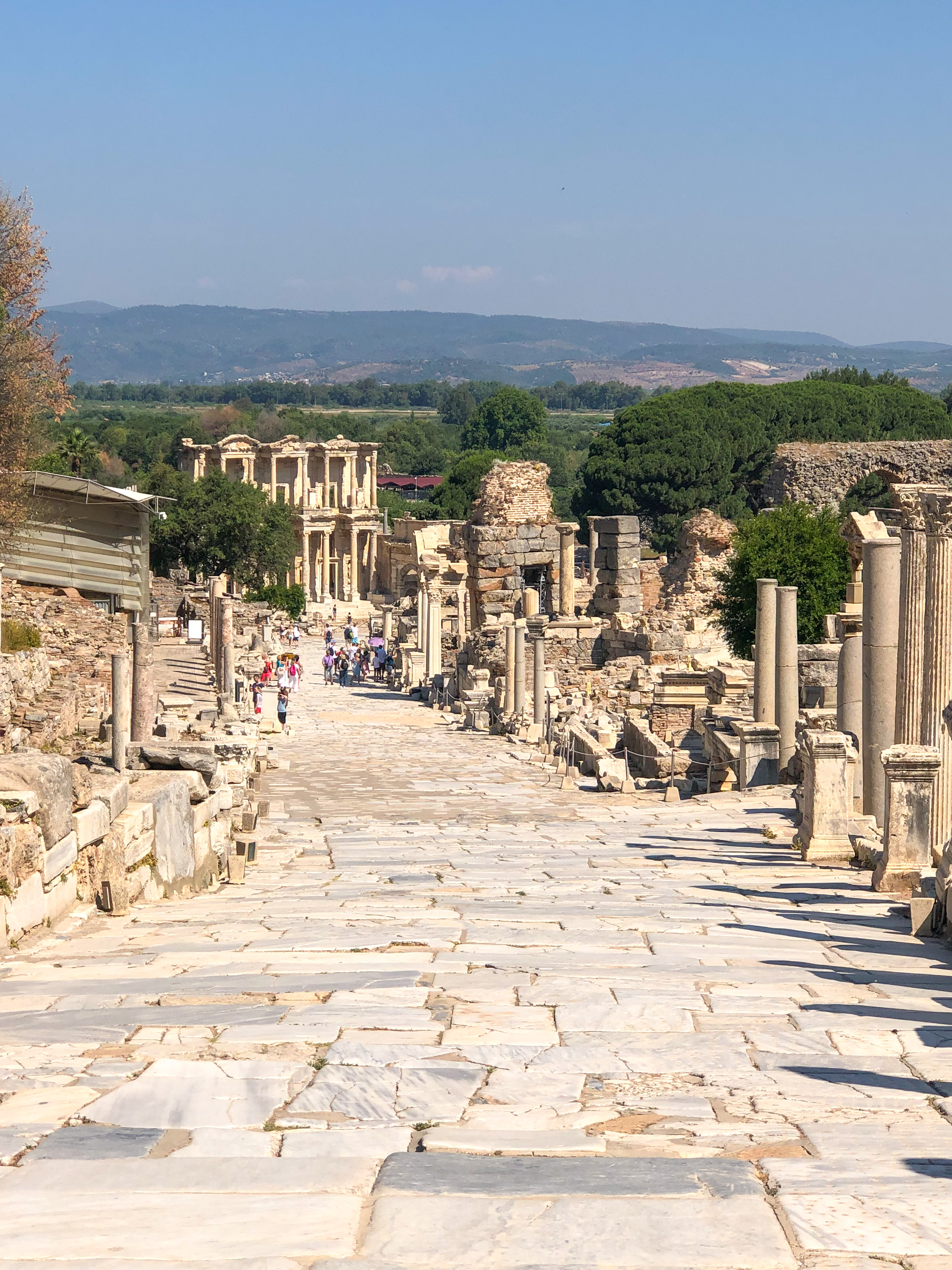
Next up on your stroll through Ephesus you walk down the Curetes Road. This impressive street was reserved for horses and carts and if you look for it you can see the traces of the cart tracks on the road. The sidewalks were made of mosaic and the street was lined with a wood covered stoa which housed shops and houses.
On the right side of the street is the Fountain of Trajan. The U-shaped structure featured two pools behind a two story ornamental facade. Between the pillars statues of Aphrodite, Dionysus, and members of the imperial family were on display. These statues are currently on display at the Ephesus Museum in the fountains hall.
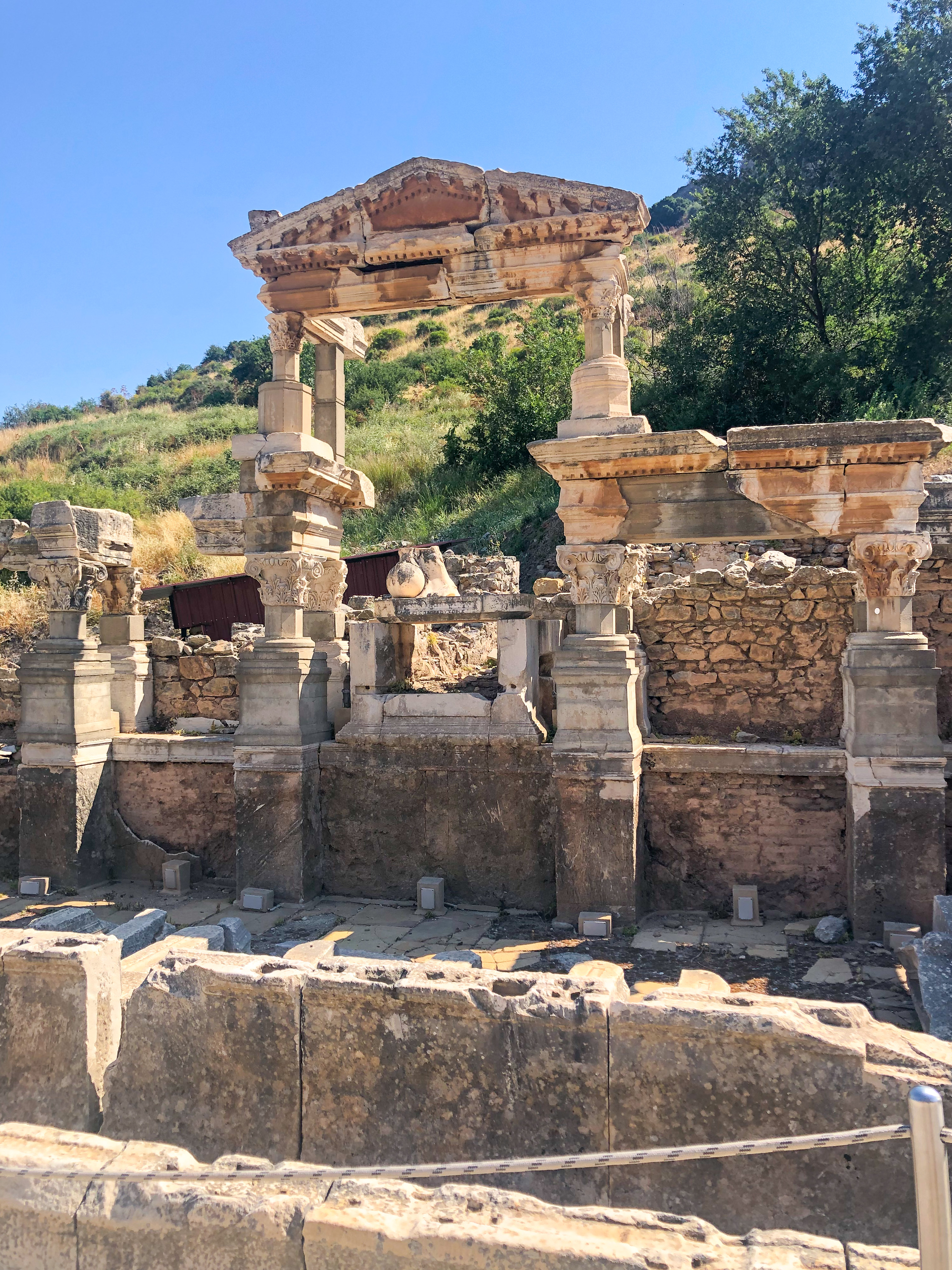
Hillside Houses
At about the halfway point through your walk through Ephesus along the Currettes Road you arrive at the Hillside Terrace Houses. A ticket is required for entry and is well worth the small bump in price.
The houses were built with a central heating system, hot and cold water, bathrooms and a kitchen. Very luxurious and in a great location in the city. On the ground floor are the kitchens and bathrooms. It was also where the servants quarters were located. Bedrooms were up a level on the first floor.

Due to fires and earthquakes the house have been rebuilt a few times and knowing that only adds to how impressive it is that they are in as good of shape as they are. The art and mosaics are gorgeous to this day! House A, even has a theatre room and has theatre scenes adorning the walls. House B has muses depicted on its walls.
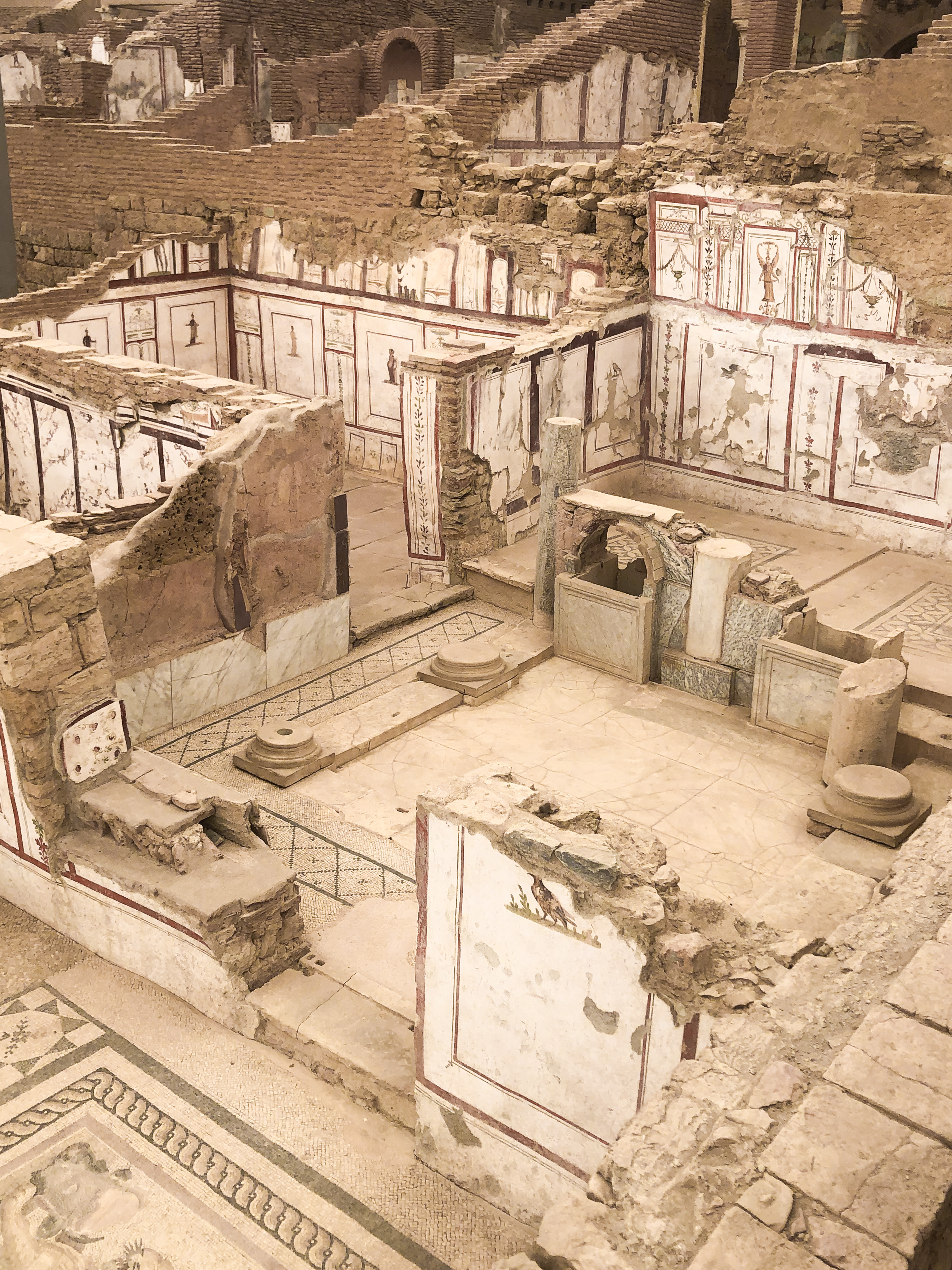
Every corner you turn or staircase you traverse give way to another interesting or beautiful scene and the signage gives you loads of insight into the houses. Whether you are into the art, the lifestyles of ancient people, or the architecture, you do not want to skip this essential part of you’re Ephesus trip. Beyond that, the houses are covered and the shade will be a nice break if you’re touring on a sunny day!
Temple of Hadrian
Across from the hillside houses is the Temple of Hadrian. The four columned temple was dedicated to Emperor Hadrian after the emperor visited Ephesus in 128 AD.
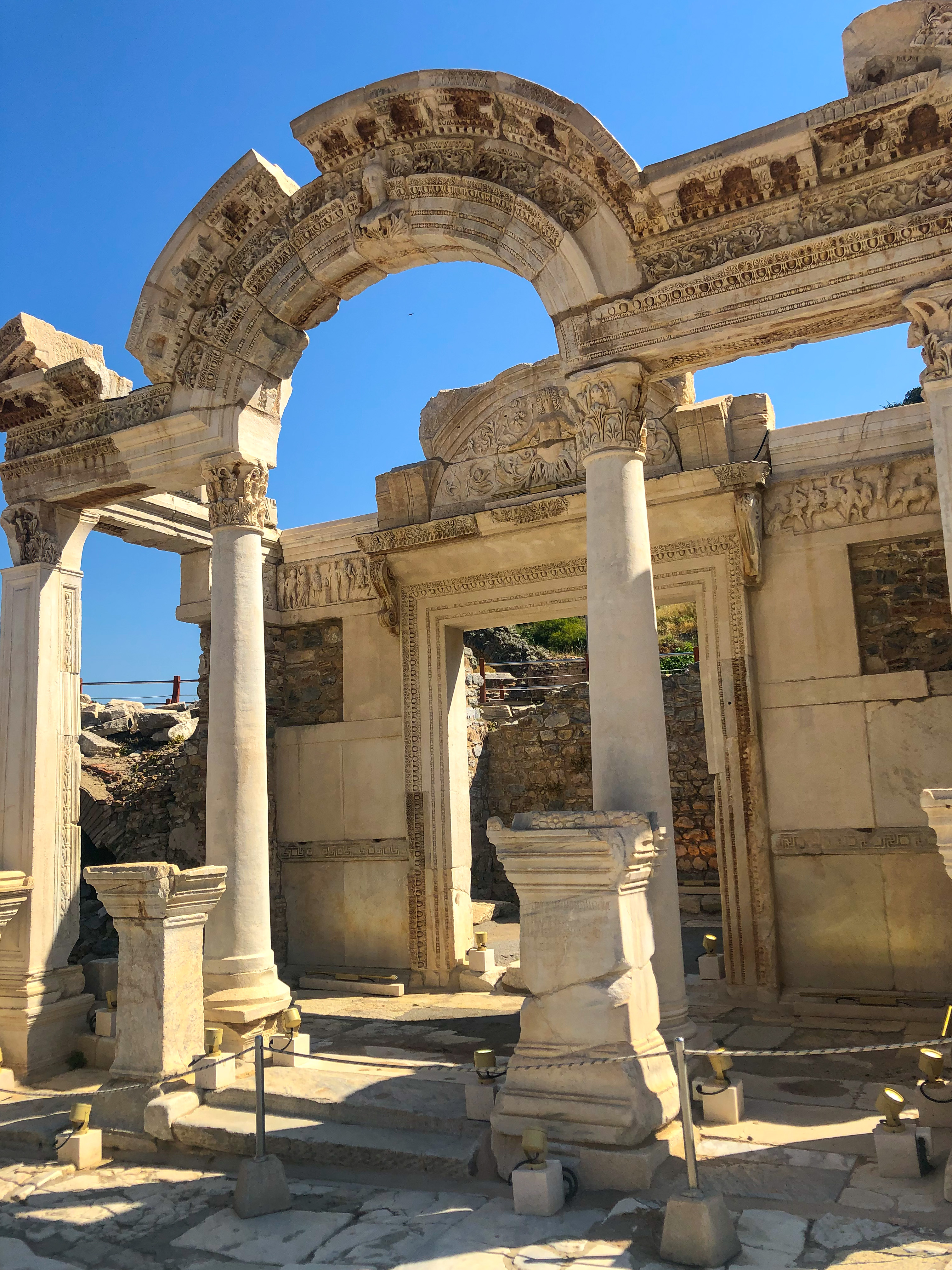
Scolastica Baths
For a pure representation of a Roman bath turn to the Scolastica Baths just past the Temple of Hadrian. You can still see the hot air pipes that run under the floor and the depressions from the marble blocks from the hypocausts that warmed the room!
Library of Celsus
The Library of Celsus is easily one of the more impressive points of Ephesus. This two story structure was built as the tomb of Tiberius Celsius Polemanus in which a sarcophagus sits in the center niche. It’s a great photo spot with all the open space and it’s impressive facade!
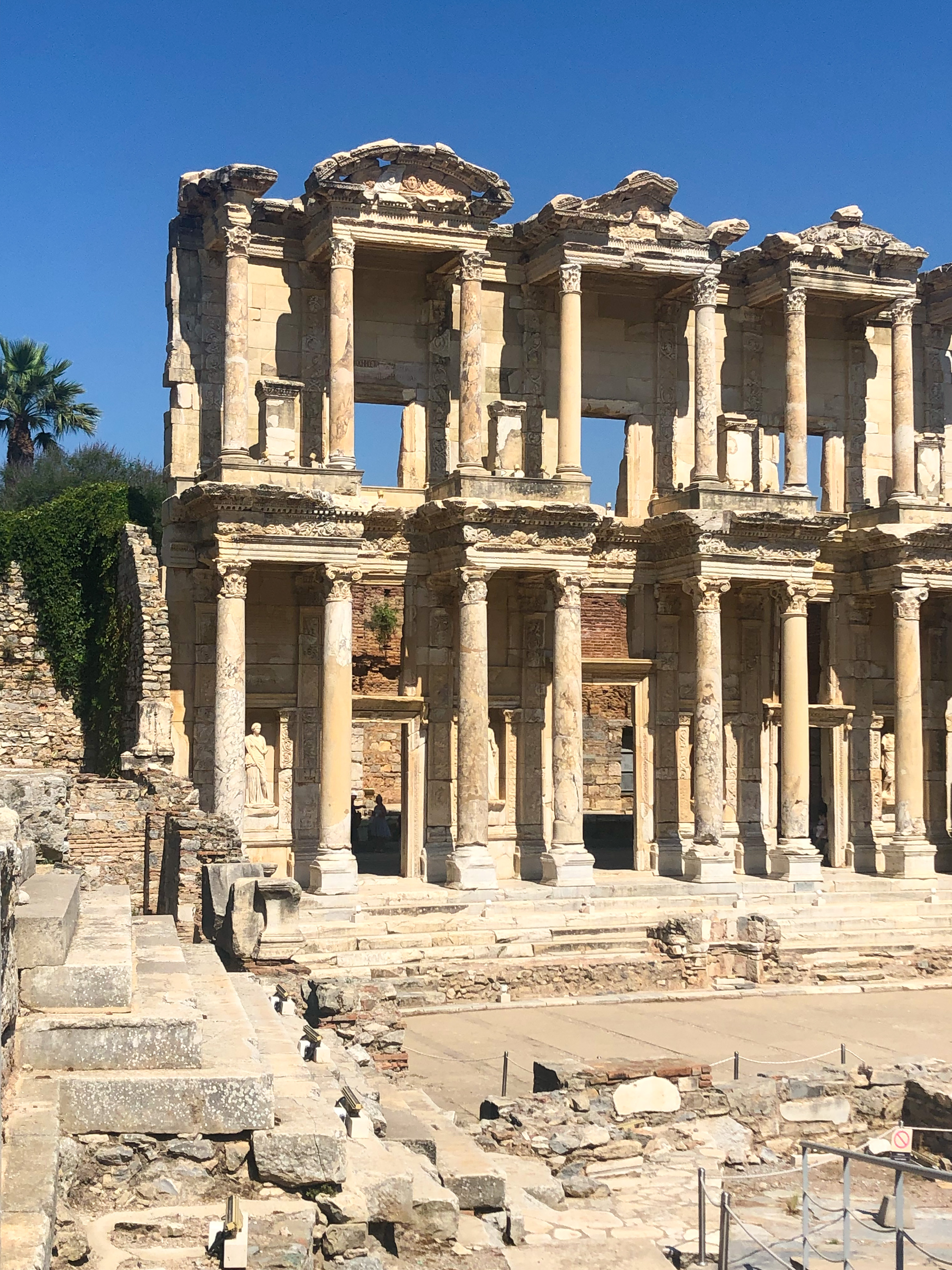
Gate of Mazeus and Mithridetes
The Gate of Mazeus and Mithridetes leads to the commercial agora of Ephesus. Built by two freed slaves and dedicated to Emperor Augustus and built in the third century BC this is an impressive entrance to an equally impressive historical center for commerce.
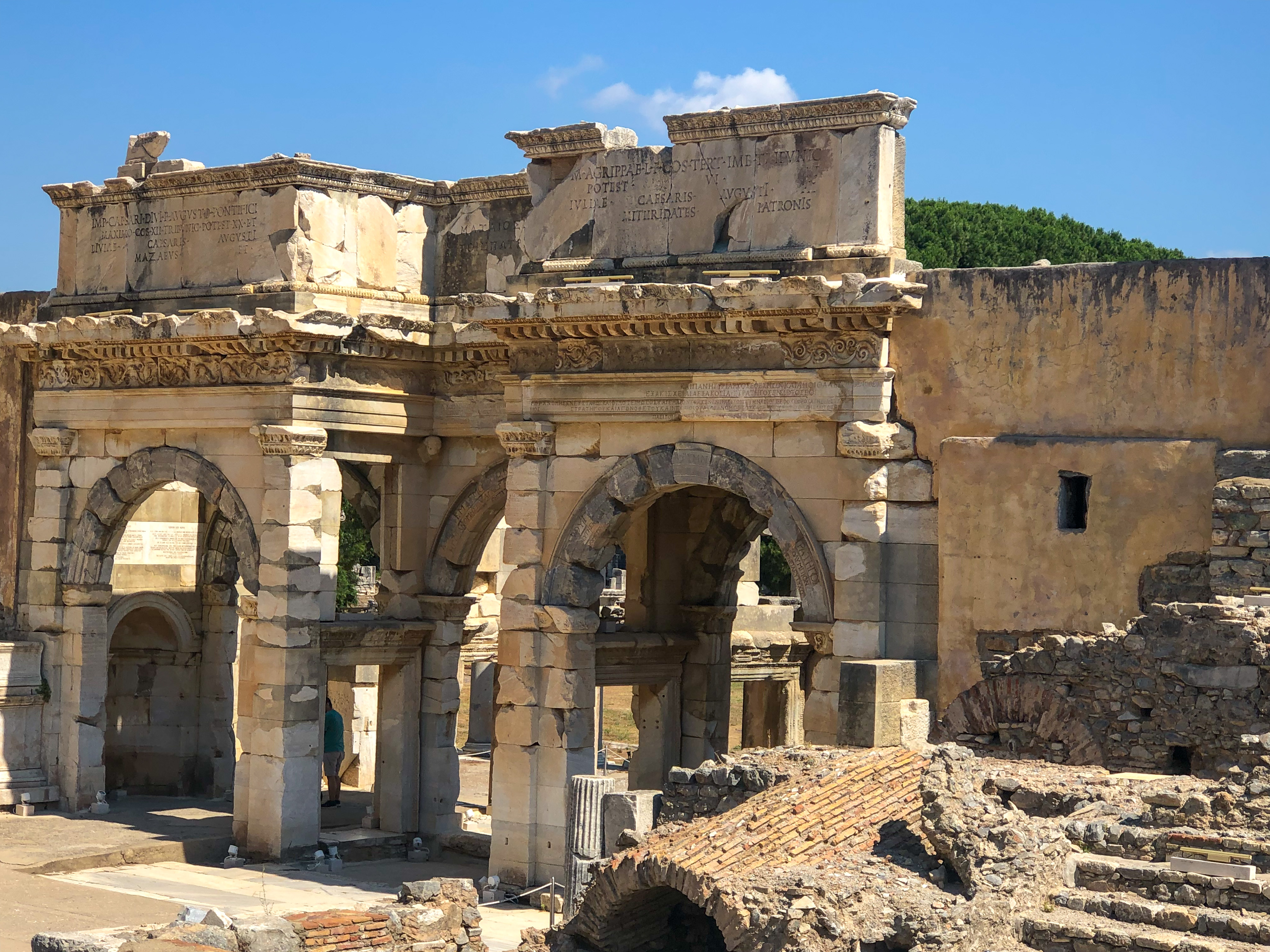
On your way to our next stop enjoy a stroll down the Marble Road and catch the breeze before the grandeur that is the Grand Theatre!
Grand Theatre
Upon your arrival to Ephesus back in it’s heyday the Grand Theatre would be your first view of the city from the harbor so, naturally, they built it to be impressive. It’s the largest theatre in Asia Minor and could seat 24000. This is also the theatre that the Apostle Paul visited when he was in Ephesus.
There’s renovation work going on but you can maneuver yourself around the theater and check it all out. Take tons of pictures and see one of the best examples of the old saying “If it ain’t broke, don’t fix it.” You can definitely tell by the acoustics and design why theaters have remained pretty much the same until today!
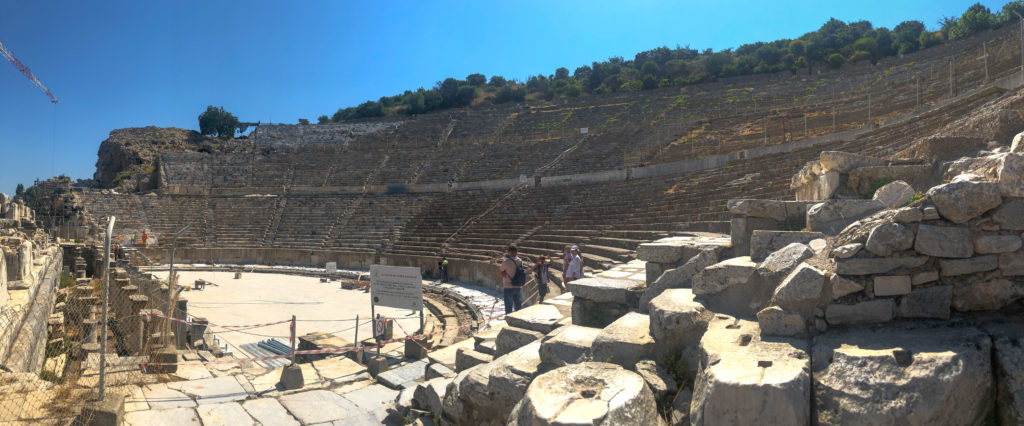
Harbour Street
If you look to the left as you make your way towards the exit to Ephesus you will see the Harbor street. The street was the man road into Ephesus from the harbor and was lit at night by lanterns. It must have been an incredibly impressive sight entering Ephesus by this street with the Great Theatre in the background.
There are sites that have not, as of yet, been excavated along this road including a wrestling school and another bath.
Conclusion
Spending time at the ancient city of Ephesus is, in my opinion, one of the must do activities if you are anywhere near the area in Türkiye. It is the most immersive exploration of an ancient city and ruins I have experienced to this day. The Hillside Houses were educational, gorgeous, and a great break from the sun. It will only become more of an adventure as time goes on and more is uncovered in the area.
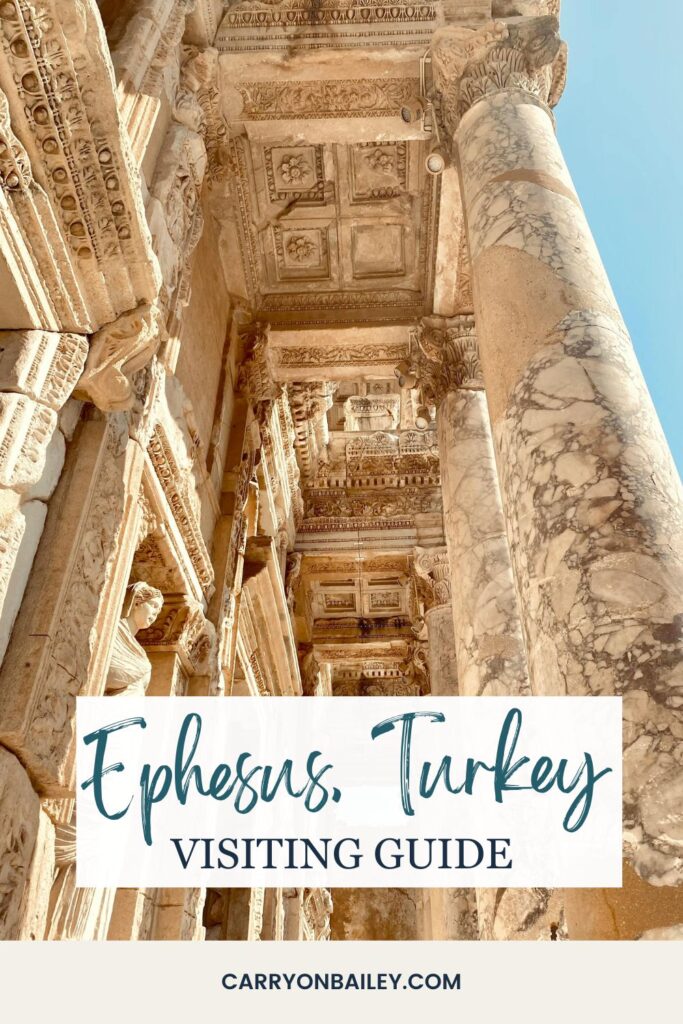
This Guide to Visiting Ephesus may contain some links that are affiliate links, though products are ones I use personally and recommend. When you purchase anything using my links, it costs you absolutely nothing extra, but it does give carryonbailey.com a little financial support which helps to keep this blog running. Thank you for your continued support, both with your dollars and your interest.
